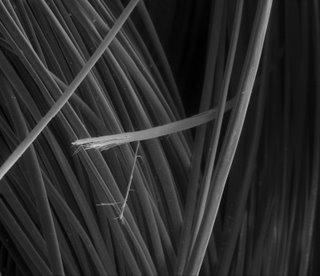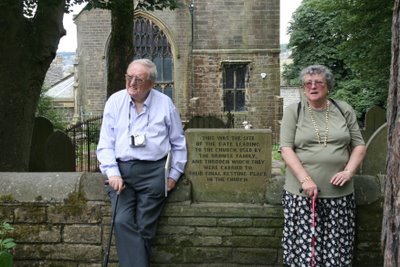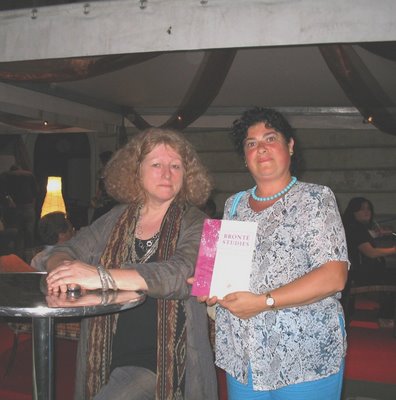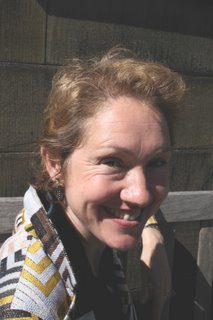 Sample of Anne's hair
Sample of Anne's hairThe Cornelia Parker Exhibition launches the Brontë Contemporary Arts Programme.
An ambitious project to establish the Brontë Parsonage Museum in Haworth as a vibrant centre for the creative arts will be officially launched with a stunning new exhibition by one of Britain's most famous artists, and Turner Prize nominee, Cornelia Parker.
Cornelia Parker's
Brontëan Abstracts exhibition will run from Saturday 16 September to Sunday 31 December 2006 and will, most unusually, be displayed within period rooms of the Parsonage. Cornelia has been working with the Museum over the past year developing new work which will offer visitors a unique opportunity to see the Brontës interpreted through the work of a major contemporary British artist.
She has been exploring the Museum's collection, viewing original Brontë manuscripts in the British Library and working with the University of Bradford analysing samples of Brontë hair, using electron microscope imaging technology. The exhibition will include a series of images of Brontë artefacts, including samples of hair produced using this method.
“By capturing images of the Brontës' relics through a microscope,” she explained, “I have been using the tools of science to try to understand the power of the myth. Whether it is a split end of Anne's hair or pinholes made by Charlotte or the tines of a comb burnt by Emily, they are abstractions made by them, unconsciously.”
The Brontë Parsonage Museum has, over the years, attracted international artists, authors and film-makers all keen to interpret the lives of one of the most famous literary families of all time. The Museum is seeking to use the historic home of the Brontës in a new and dynamic way to bring the collections to life for visitors and make new connections with the creative arts.
Andrew McCarthy, Parsonage Deputy Director, said, “Exhibiting work by such a prominent artist is very exciting and an historic opportunity for the Museum.
“Cornelia Parker is interested in people, places and objects which have become so established within public consciousness as to have taken on a monumental quality. This is certainly true of the Brontës.
“The problem with monuments is that they can become caricatures and Brontëan Abstracts will challenge some of our preconceptions about the Brontës and give us a new perspective on them”.
The exhibition was made possible with support from
Illuminate, The Esmée Fairburn Foundation and The Henry Moore Foundation. The Illuminate festival is a programme of arts and cultural events taking place in the five Yorkshire cities of Bradford, Hull, Leeds, Sheffield and York from October 2005 to October 2006 and has been funded by the DCMS.
The Parsonage will be contributing to the festival with a week-long programme of Brontë events from Saturday 16 September 2006 to Sunday 24 September 2006.
The Parsonage Contemporary Arts Programme, which has Professor Germaine Greer as Honorary Patron, will include visual arts, theatre, music, poetry, talks and workshops involving visiting authors, and more Please see the Parsonage website for further information - www.bronte.info
This media release is from Diane Benn
Cornelia Parker BiographyCornelia Parker was born in Cheshire in 1956 and lives and works in London. She studied at Gloucestershire College of Art and Design, Wolverhampton Polytechnic and at Reading University.
She is best known for a number of large-scale installations including Cold Dark Matter: An Exploded View (1991), and The Maybe (1995), a collaboration with actress Tilda Swinton, who appeared sleeping inside a vitrine at the Serpentine Gallery.
In tandem with large projects like these she has also made an ongoing series of smaller works entitled Avoided Object, working in collaboration with numerous institutions including HM Customs & Excise, The Royal Armouries and Madame Tussauds.
In 1997 she was awarded a residency at ArtPace in San Antonio, Texas and was shortlisted for the Turner Prize, Tate Gallery, London. In 1998 she had major solo exhibitions at the Serpentine Gallery, London, and Deitch Projects, New York. A retrospective of her work was held at the ICA Boston in 2000. In 2001, the Galeria de Arte Moderne in Turin presented a major one-person show, and the Victoria & Albert Museum in London commissioned a permanent installation for the British Galleries.
Recent group exhibitions include The Tate Triennale, Tate Britain 2003 and The Disembodied Spirit, Bowdoin Museum of Art, USA. She has works in the Tate Collection and in numerous public and private collections in Europe and the USA. She is represented by Frith Street Gallery, London.












